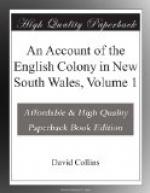In addition to fish, they indulge themselves with a delicacy which I have seen them eager to procure. In the body of the dwarf gum tree are several large worms and grubs, which they speedily divest of antennae, legs, etc. and, to our wonder and disgust, devour. A servant of mine, an European, has often joined them in eating this luxury; and has assured me, that it was sweeter than any marrow he had ever tasted; and the natives themselves appeared to find a peculiar relish in it.
The woods, exclusive of the animals which they occasionally find in their neighbourhood, afford them but little sustenance; a few berries, the yam and fern-root, the flowers of the different banksia, and at times some honey, make up the whole vegetable catalogue.
The natives who live in the woods and on the margins of rivers are compelled to seek a different subsistence, and are driven to a harder exercise of their abilities to procure it. This is evinced in the hazard and toll with which they ascend the tallest trees after the opossum and flying squirrel. At the foot of Richmond Hill, I once found several places constructed expressly for the purpose of ensnaring animals or birds. These were wide enough at the entrance to admit a person without much difficulty; but tapering away gradually from the entrance to the end, and terminating in a small wickered grate. It was between forty and fifty feet in length; on each side the earth was thrown up; and the whole was constructed of weeds, rushes, and brambles: but so well secured, that an animal once within it could not possibly liberate itself. We supposed that the prey, be it beast or bird, was hunted and driven into this toil; and concluded, from finding one of them destroyed by fire, that they force it to the grated end, where it is soon killed by their spears. In one I saw a common rat, and in another the feathers of a quail.
By the sides of lagoons I have met with holes which, on examining, were found excavated for some space, and their mouths so covered over with grass, that a bird or beast stepping on it would inevitably fall in, and from its depth be unable to escape.
In an excursion to the Hawkesbury, we fell in with a native and his child on the banks of one of the creeks of that noble river. We had Cole-be with us, who endeavoured, but in vain, to bring him to a conference; he launched his canoe, and got away as expeditiously as he could, leaving behind him a specimen of his food and the delicacy of his stomach; a piece of water-soaked wood (part of the branch of a tree) full of holes, the lodgment of a large worm, named by them cah-bro, and which they extract and eat; but nothing could be more offensive than the smell of both the worm and its habitation. There is a tribe of natives dwelling inland, who, from the circumstance of their eating these loathsome worms, are named Cah-bro-gal.
They resort at a certain season of the year (the month of April) to the lagoons, where they subsist on eels which they procure by laying hollow pieces of timber into the water, into which the eels creep, and are easily taken.




